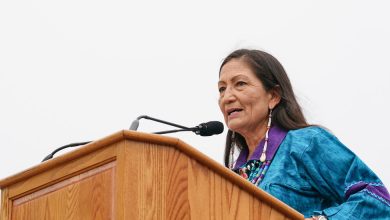Tesla Reports 87% Increase in 2021 Deliveries

Tesla reported Sunday that it delivered 936,000 cars in 2021, an 87 percent increase from the year before, despite the computer chip shortage that has disrupted auto production around the world.
In the fourth quarter alone, the company delivered more than 308,000 vehicles, a 71 percent increase from the quarter a year earlier. The overwhelming share of the deliveries were of the Model 3 sedan and the Model Y hatchback.
Tesla does not break out its deliveries by country. Much of its recent growth has been propelled by sales in Europe and China.
The jump in deliveries capped a momentous year in which Tesla saw its stock and profits soar. It has also worked to open factories near Austin, Tex., and Berlin, in Germany, in hopes of sustaining its rapid growth.
In October, Tesla’s market value for the first time exceeded $1 trillion, making it more valuable than General Motors, Ford Motor, Toyota, Volkswagen, Stellantis, BMW and several other automakers combined.
Understand the Supply Chain Crisis
- The Origins of the Crisis: The pandemic created worldwide economic turmoil. We broke down how it happened.
- Explaining the Shortages: Why is this happening? When will it end? Here are some answers to your questions.
- Gifts Arrive on Time: Fears that a disrupted supply chain could wreak havoc on the holidays turned out to be wrong. Here’s why.
- Car Shortages: The limited supply of vehicles is forcing some to go to great lengths to find them, including traveling hundreds of miles.
- A Key Factor in Inflation: In the U.S., inflation is hitting its highest level in decades. Supply chain issues play a big role.
On Friday, Tesla’s stock closed at $1,056.78, up from just under $700 at the end of 2020. The stock’s rise was fueled by increasing sales and profits. In the third quarter, the company earned $1.6 billion, more than double its earnings in all of 2020, its first profitable year.
With shares at dizzying heights, Elon Musk, Tesla’s chief executive, began selling large chunks of his stock, partly to cover taxes, after taking a poll among his followers on Twitter. Several times he said he was done selling but continued.
In total, Mr. Musk sold more than $16 billion worth of Tesla stock. The transactions involved the exercising of 22.8 million options awarded to Mr. Musk as part of his compensation and bonus packages.
Tesla has said it hopes deliveries will increase about 50 percent a year for the next several years, and is counting on output from its Austin and Berlin factories to reach its goal. Both factories are expected to begin producing Model Y hatchbacks soon.
At the same time, Tesla’s product quality has remained uneven. On Thursday, the company told federal regulators that it planned to recall more than 475,000 cars for two separate defects that could affect safety — a misaligned latch on the front hood, which could allow the hood to open unexpectedly, and wiring to the rearview camera that can be damaged by opening and closing the trunk. A day later, vehicles in China were recalled as well.
How the Supply Chain Crisis Unfolded
The pandemic sparked the problem. The highly intricate and interconnected global supply chain is in upheaval. Much of the crisis can be traced to the outbreak of Covid-19, which triggered an economic slowdown, mass layoffs and a halt to production. Here’s what happened next:
A reduction in shipping. With fewer goods being made and fewer people with paychecks to spend at the start of the pandemic, manufacturers and shipping companies assumed that demand would drop sharply. But that proved to be a mistake, as demand for some items would surge.
Demand for protective gear spiked. In early 2020, the entire planet suddenly needed surgical masks and gowns. Most of these goods were made in China. As Chinese factories ramped up production, cargo vessels began delivering gear around the globe.
Then, a shipping container shortage. Shipping containers piled up in many parts of the world after they were emptied. The result was a shortage of containers in the one country that needed them the most: China, where factories would begin pumping out goods in record volumes
Demand for durable goods increased. The pandemic shifted Americans’ spending from eating out and attending events to office furniture, electronics and kitchen appliances – mostly purchased online. The spending was also encouraged by government stimulus programs.
Strained supply chains. Factory goods swiftly overwhelmed U.S. ports. Swelling orders further outstripped the availability of shipping containers, and the cost of shipping a container from Shanghai to Los Angeles skyrocketed tenfold.
Labor shortages. Businesses across the economy, meanwhile, struggled to hire workers, including the truck drivers needed to haul cargo to warehouses. Even as employers resorted to lifting wages, labor shortages persisted, worsening the scarcity of goods.
Component shortages. Shortages of one thing turned into shortages of others. A dearth of computer chips, for example, forced major automakers to slash production, while even delaying the manufacture of medical devices.
A lasting problem. Businesses and consumers reacted to shortages by ordering earlier and extra, especially ahead of the holidays, but that has placed more strain on the system. These issues are a key factor in rising inflation and are likely to last for months — if not longer.
In addition, the company and its Autopilot driver-assistance system have come under closer scrutiny by safety regulators in the United States. Teslas have been involved in a series of crashes with other vehicles, including some that resulted in fatalities, while the Autopilot system was engaged.
The company continues to promote its Autopilot system, which can take over some of the steering, braking and accelerating tasks from drivers, and a more advanced set of features, Full Self Driving, that it offers for $10,000 but has so far allowed only a select group of customers to test.
In August, the National Highway Traffic Safety Administration opened a formal investigation into how Autopilot recognizes objects on the road. It is specifically looking into 11 instances when Teslas crashed into emergency vehicles that had stopped on highways and had their lights flashing.
The agency is also looking at more than two dozen other crashes involving Teslas that were under Autopilot control. Eight of those crashes have resulted in a total of 10 deaths since the first occurred in 2016.



